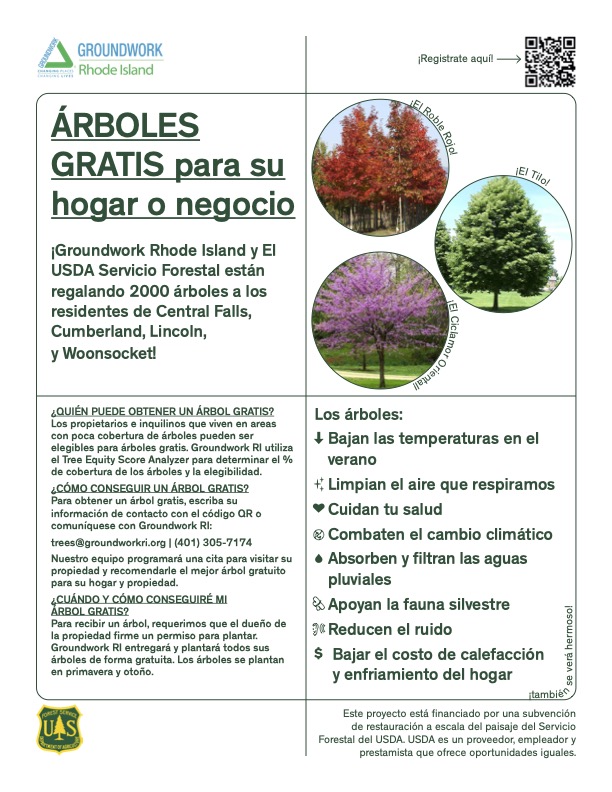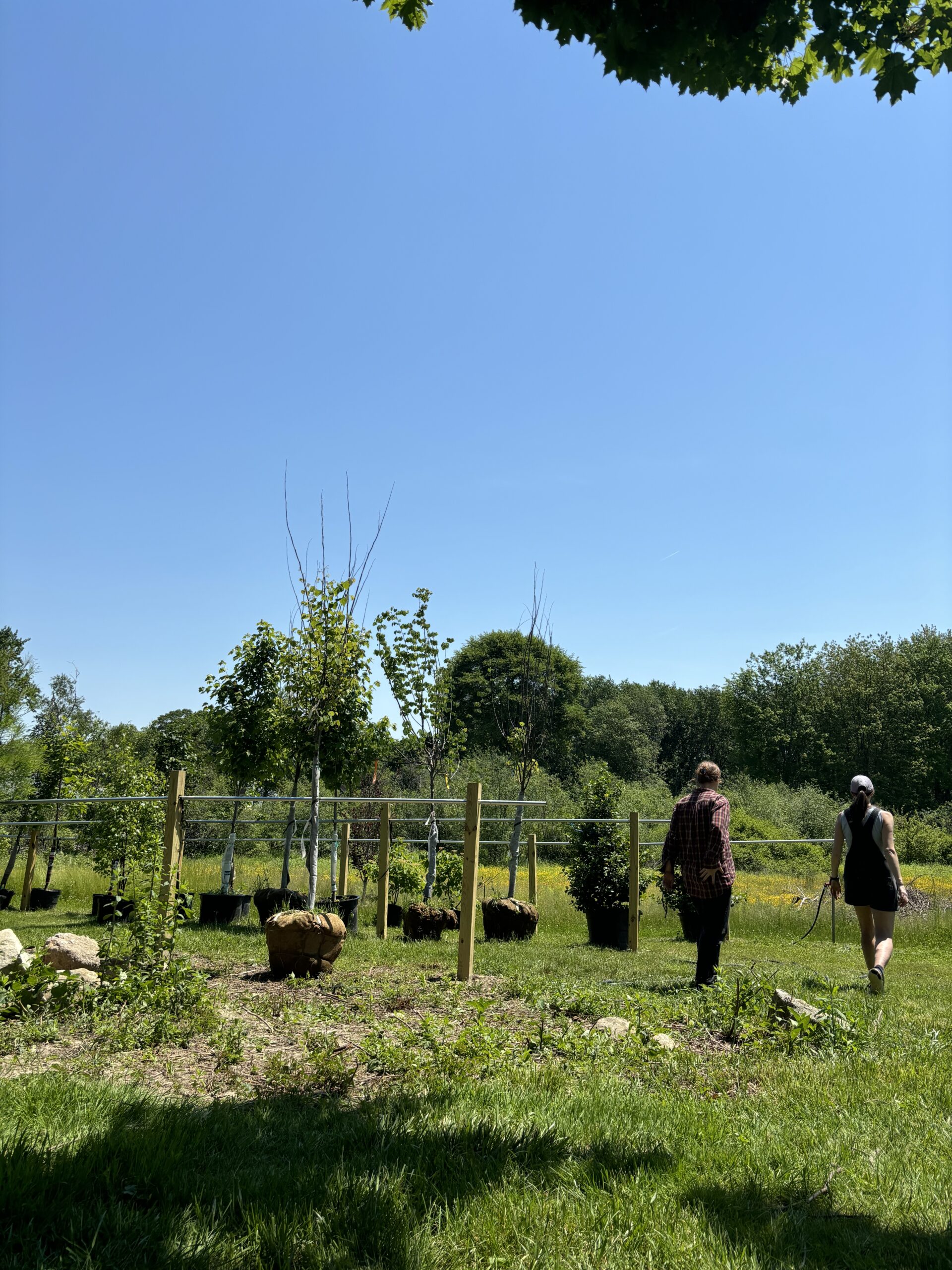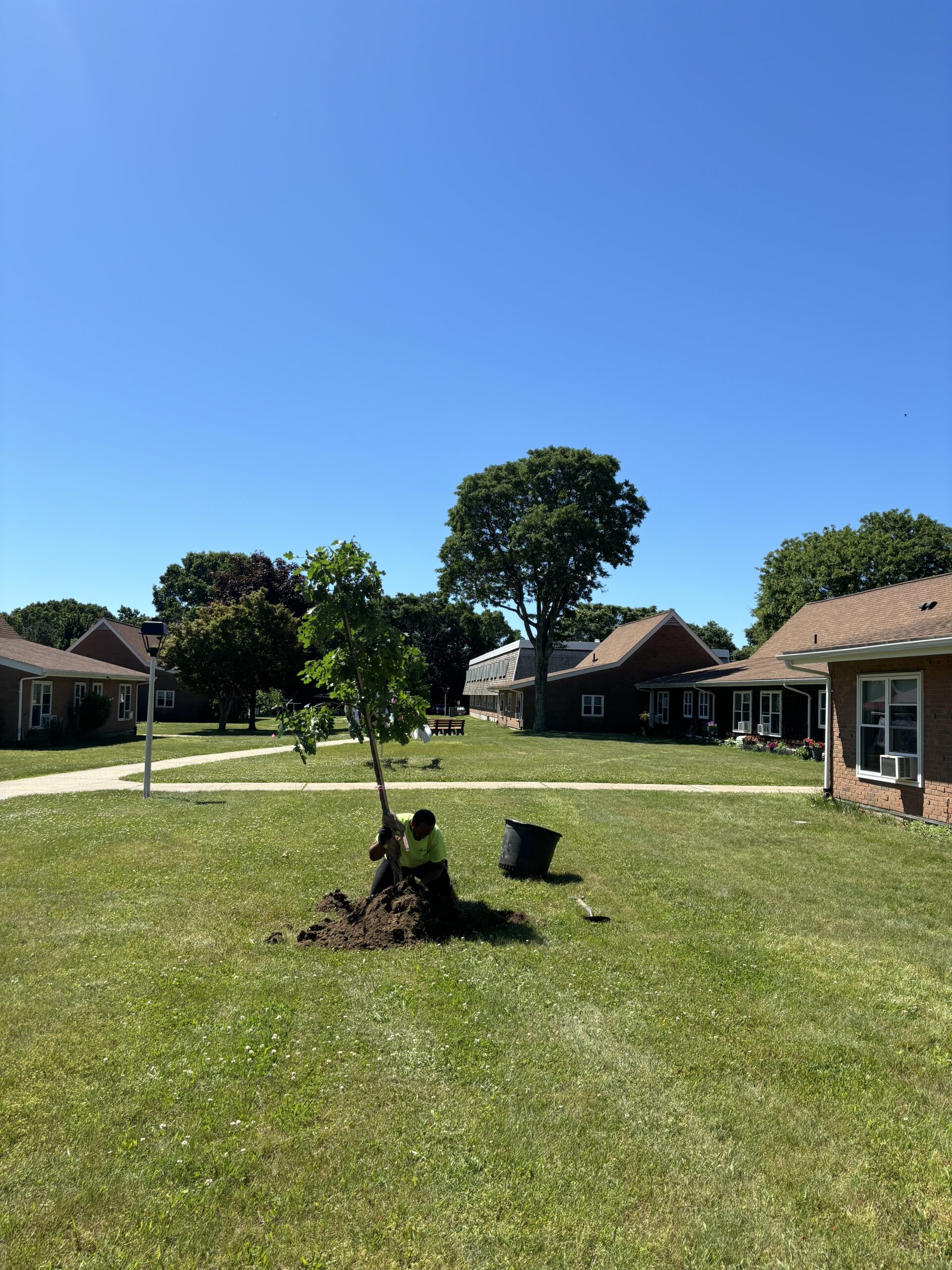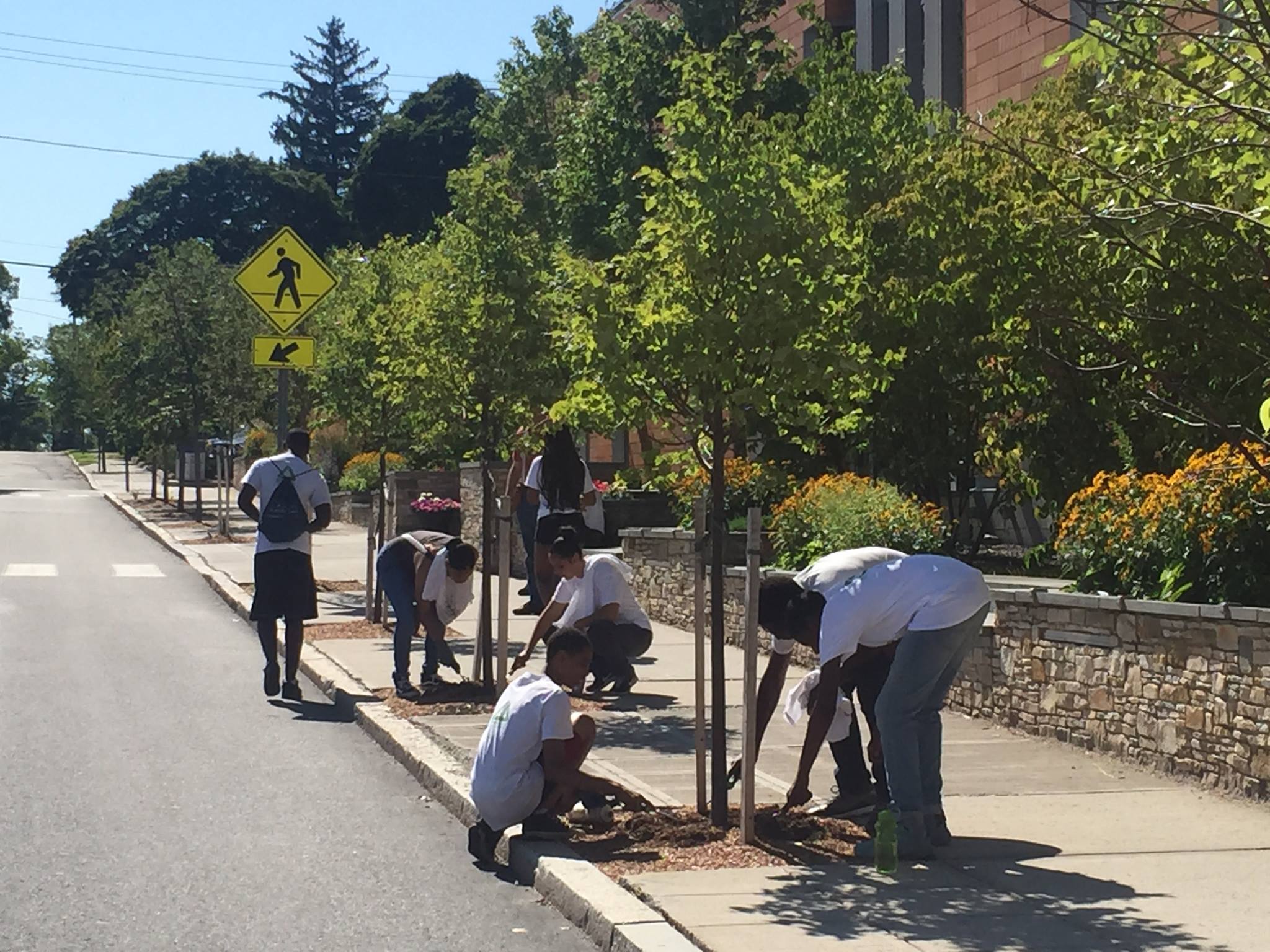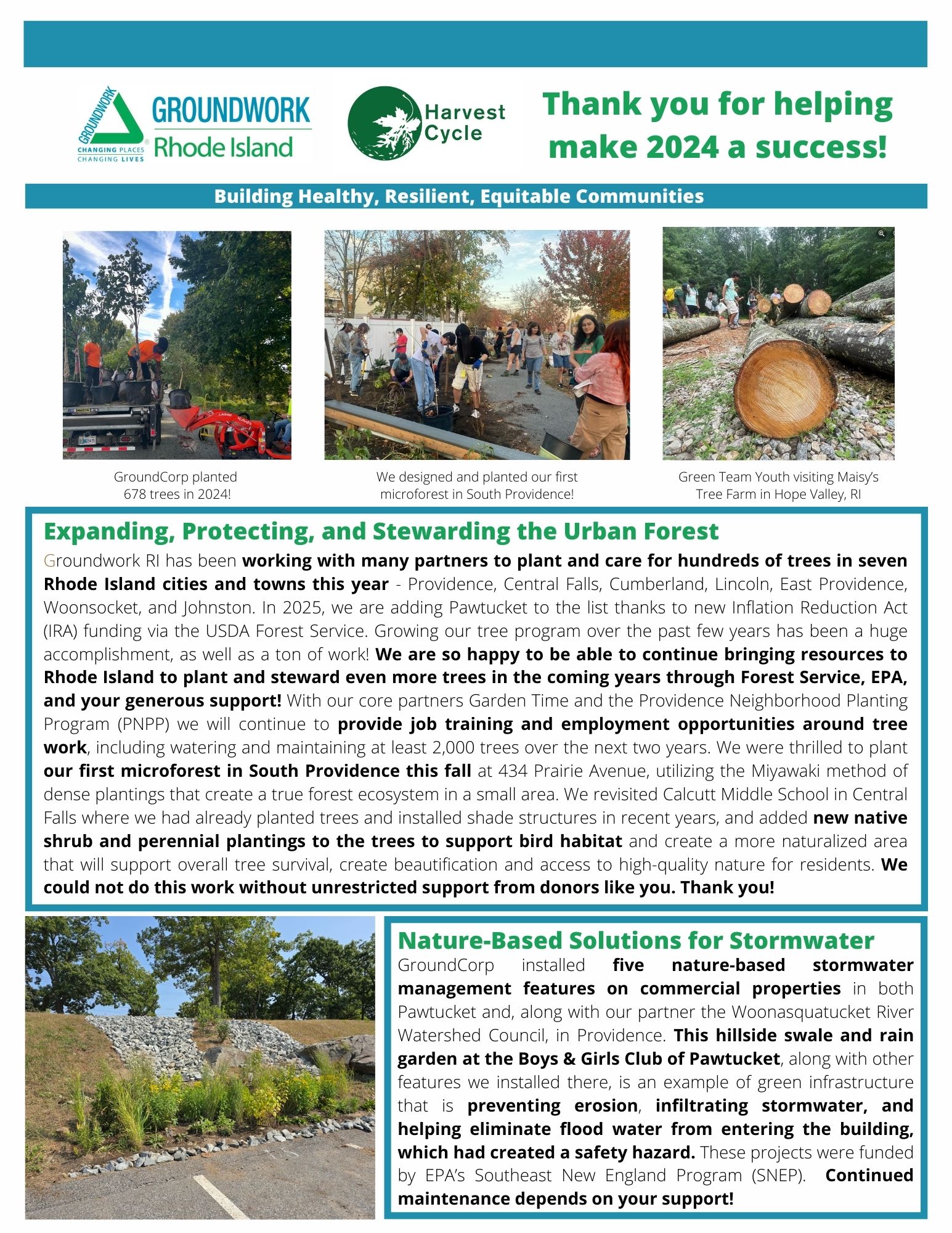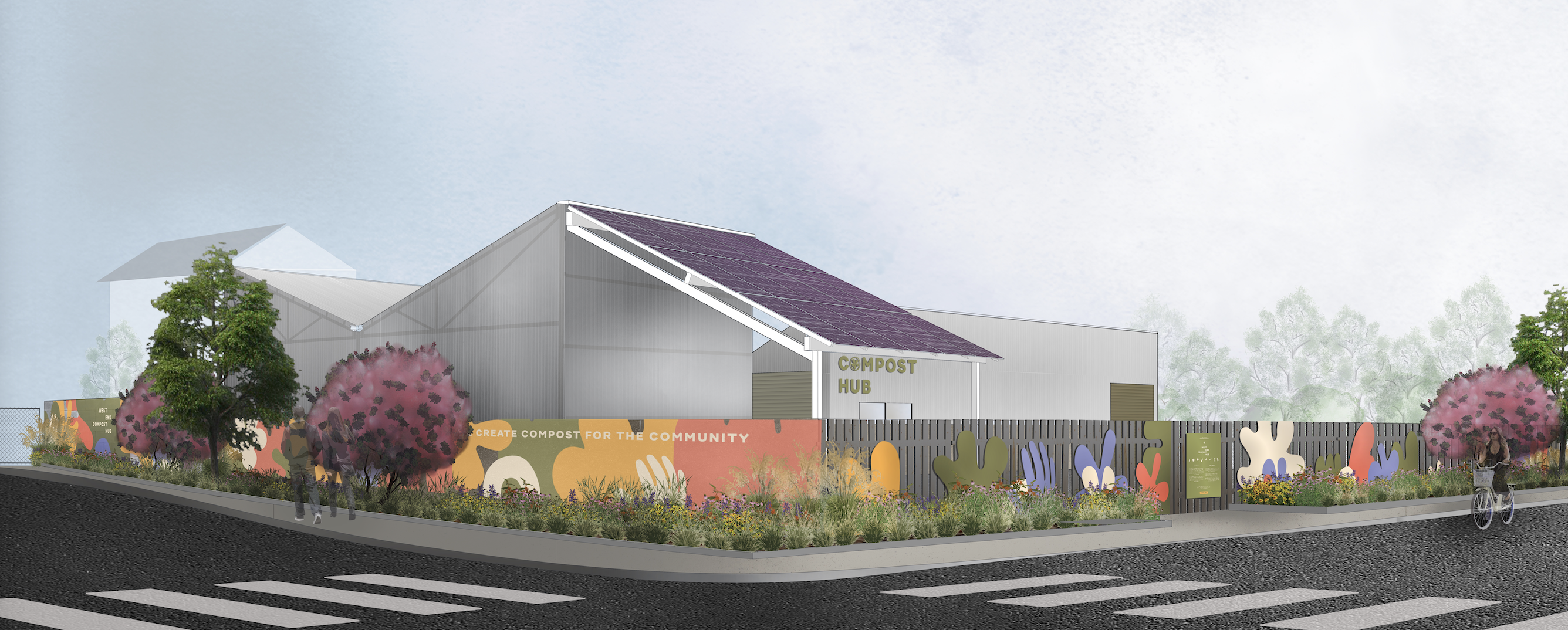Urban Forestry
Harvest Cycle Compost
Urban Forestry
Trees offer substantial benefits to the community, your finances, and the environment. By providing shade, they help cool neighborhoods during the hot summer months, which can significantly reduce energy costs when planted around homes. Their leaves also serve as natural sound barriers, reducing noise pollution in the neighborhood.
Trees play a crucial role in improving air quality. They absorb carbon dioxide—a major greenhouse gas—along with other pollutants, and release oxygen in return. Research has shown a link between high asthma rates in both children and adults and low tree coverage in neighborhoods. Planting more trees can help mitigate this issue.
In addition to their above-ground benefits, trees improve soil water retention and drainage through their root systems, reducing the risk of flooding. Overall, increasing tree cover in urban areas enhances community well-being, environmental health, and economic savings.
Tree Planting Programs
Planting Programs are funded by grants with specific allotments of trees, neighborhoods, and timelines. Currently, Groundworks have 3 active grants:
Additional Environmental Project
The Attorney General’s Office has awarded an Additional Environmental Project (AEP) grant, sourced from pollution penalty funds from Sims Metal Recycling in Lower South Providence. This grant allows for the planting of trees at homes, businesses, and along sidewalks. Property owners and renters in Lower South Providence and Washington Park may be eligible for a free tree to be planted on their sidewalk or property. With this funding, 400 trees can be planted, and GroundWorks has already planted more than 300!
Supplemental Environmental Project
The Supplemental Environmental Project (SEP) is provided by _________ for private properties in Johnston, RI. Homeowners, renters, and businesses can sign up to determine their eligibility for a free tree.
Landscape Scale Restoration
The Landscape Scale Restoration (LSR) grant from the USDA Forest Service is one of GroundWorks RI’s largest grants. This grant will facilitate the planting of 2,000 trees across five cities in Rhode Island: Woonsocket, Lincoln, Central Falls, Cumberland, and Lower South Providence. These trees are allocated for private properties such as homes and businesses. Property owners and renters in areas with low tree canopy cover may be eligible for a tree from this grant. So far, GroundWorks has planted 482 trees, with two more years remaining before the grant expires in 2027.
Get a Free Tree
Groundworks RI receives grants that outline where trees can be planted; working also within the individual city regulations, Groundworks RI offers free trees for private property (including homes and businesses whether you rent or own) and also sidewalk trees. Tree planting is focused on neighborhoods with low tree canopy cover. If you are unsure if you are eligible for a free tree, please contact us trees@groundworkri.org or (401) 305-7174.

If you don’t qualify what are other ways to get free trees
If you are not eligible for a free tree through Groundworks RI’s current projects, there are more organizations that may be offering free trees in your area. The Providence Neighborhood Planting Program (PNPP) works to plant free trees in the Providence area. Residents, business owners, or community members can apply as a group to receive free street trees in their neighborhood in exchange for helping to plant and take care of the young trees alongside their neighbors. Contact PNPP : info@pnpp.org or (401) 484-7359
Types of Trees We Plant
Planting native tree species in urban areas is crucial because these trees are inherently adapted to the local environment, requiring less maintenance and being more resilient to local pests and diseases. Native trees thrive in their natural habitat’s soil and climate conditions, ensuring healthier and longer-lived urban tree canopy. Additionally, they provide essential habitat and food sources for native wildlife, promoting biodiversity and supporting local ecosystems. We focus on planting a wide variety of native trees as this diversity enhances the resilience of urban forests. Biodiversity strengthens ecosystems by providing a wider range of species that can adapt to and recover from climate change, extreme weather events, and disease outbreaks. This resilience helps maintain ecological balance, ensuring that the urban environment remains robust and sustainable. Native trees also help preserve the region’s natural heritage and can enhance the aesthetic and cultural value of urban green spaces. Overall, they contribute to a sustainable, balanced urban environment, reducing the need for chemical interventions and extensive water use. Below are some of Rhode Island’s native trees!
Trees Planted by Groundworks RI
Groundworks RI has been working to plant tree throughout Providence, and has recently expanded to a state wide effort to reduce low tree canopy area. Over 2,000 trees have been planted since _____(year).
Tree Maintenance & Gardening Information
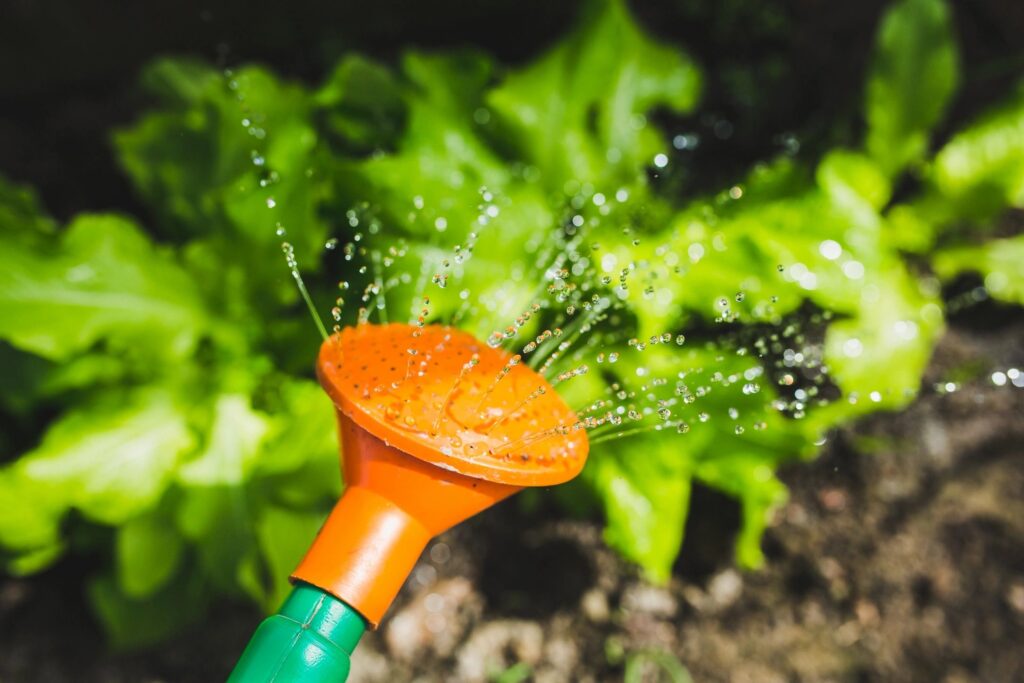 Watering Guide
Watering Guide
Watering is the most important thing to do to ensure your tree’s survival! When we plant it we will create a bermed bowl around the tree to hold the water so that it infiltrates without running off. The berm should be filled with about 5 gallons of water. At the end of the season the berm can be knocked down and spread onto the base of the tree. Try to follow this watering schedule:
First two weeks: your new tree should be watered 5 gallons every day, or as many days as you are able.
The next six weeks: give your tree 5 gallons of water three times per week. After this, just water once per week through the growing season!
If it’s super hot, the tree might need a little extra! If you notice your tree has wilting, yellowing, or brown leaves in the summer, this is a sign that it needs more water.
Watering can be difficult, using techniques such as slow drain watering can reduce heavy lifting and frequent watering. Check out the videos below on watering.
Deer Protection
Deers are in our natural environment and they love young trees for their leaves, berries, and bark. Unfortunately this can sometimes damage young trees, hindering their growth. There are a few easy ways to protect your trees from harmful damage that can be caused by deer.
Wire tree guard:
2 aluminum posts
2x3in square galvanized wire fencing with plastic coating
Place 2 aluminum posts across from each other, 1.5 ft from the tree trunk. Cut fencing to an appropriate length to wrap around the tree and two posts, see video. Wrap around the tree and secure the fence on the posts.
Pruning Tips
Pruning works to keep your tree manageable, healthy, and producing fruit. Don’t prune your young tree too much! You can prune off any dead branches or competing leaders (the leader is the vertical stem at the top of the trunk) but otherwise, don’t prune! Check out our diagram below.
Soil Testing & Mulch
Soil testing may be something to consider if plants in your yard have had trouble growing or to see if you have the right soil nutrients and pH for sensitive plants. Free soil testing is available through the University of Rhode Island; URI Master Gardener volunteers conduct free soil pH testing as a service to the residents of Rhode Island and surrounding areas from March through October. The test helps determine soil pH levels and predominant soil texture, and provides basic information and recommendations for gradual correction of soil pH and compaction issues. Testing here.
Comprehensive soil testing can be completed by UMass Amherst by following their guide.
Keeping 1-2″ of mulch piled in a donut shape around your tree helps it in four ways. It keeps the soil moist, replenishes nutrients to the soil as it decays, suppresses weeds from growing, and it insulates the soil from extreme temperatures. It can also help keep lawn mowers clear of your tree!
Careful! Don’t pile the mulch up directly around the base of the tree trunk as this can cause it to rot. Leave 2-3″ of space around the root flare (this is the part of the trunk that widens out like a skirt at the very bottom). Using undyed mulch is best, aged wood chips and shredded bark are great options. To allow the tree to breathe, its important to leave the bottom of the tree, called the root flare, exposed.
Weeding & Fertilizer
Keep other plants away from the base of your tree! They will compete with the tree for water. Litter is a common problem as well, especially for street trees, so feel free to pick up debris you see especially after it rains!
Your tree does not need fertilizer its first year. After that, look up your tree species to see if it would benefit from fertilizer and what time of year is best to add it. Try to use organic fertilizer or compost as chemical fertilizers can contribute to water pollution.
Fruit Tree Maintenance
Growing fruit trees at home is fun and easy, while providing you with fresh fruit year after year! Fruit trees include cherry, apple, crabapple, persimmon, pears, peaches, plums, etc.
Grass and Weeds:
Minimizing competition for water and nutrients is critical for your tree, this can be accomplished through mulching and permanent sod to suppress weed growth and retain soil moisture. Mulch does decompose overtime, though it helps to improve soil structure and release nutrients for the tree to use. Apply mulch about 4 inches deep, which will settle over time. Maintain a 2in to 4in mulch cover.
Fertilizing:
Minimal fertilizer is needed within the first year a fruit tree is planted. Most soils contain the proper nutrients required for robust growth. However, if your tree does not live in nutrient rich soil, nitrogen fertilizers can be applied, about 0.04lb/tree nitrogen and 2oz of 33% ammonium nitrate. You may notice signs of low nutrients including decreased vegetative growth, low fruit output, and small fruit.
Pruning:
The age of wood growing on a fruit tree impacts the fruit production. Apples, pears, cherries and plums produce their best fruit on 2-3 year old wood. Pruning your fruit trees can help to keep them a manageable size while encouraging lots of production of fruits. Buds at the tip of each brand produce hormones that suppress the growth of buds closer to the leader, pruning and bending branches can promote growth of new buds throughout the branch rather than just on the tip.
To get started, you need to know three basic types of pruning cuts:
• Pinching—removing growth near the apical meristem (the growing tip of a shoot) while it is still young and succulent.
• Heading—removing some, but not all, of a branch or shoot (called a shortening cut on older wood).
• Thinning—removing an entire shoot at its point of origin (called a renewal cut on older wood).
When pruning trees of all kinds, you make your cut flush with the branch collar that forms where the shoot meets the branch or trunk. Where larger branches meet the main trunk, it’s important to undercut the branch a few inches away from the trunk, then finish the cut from above. Remove the stub by cutting close to the branch collar. This helps prevent damaging the bark on the trunk. Visit page 29 for more in depth information about pruning from Cornell University.
Winter protection:
Fruit trees planted by GroundWorks RI are selected based on our USDA designated Hardiness Zone. To prepare your fruit trees to come out of winter ready for spring, it’s important to maintain your tree’s nutrients. Nitrogen helps to nourish tree, allowing them to store carbohydrates and proteins for the winter. Nitrogen should be applied in the spring, and watering of the tree should cease after mid-September, unless there’s severe drought. Many growers allow weeds to grow late in the season to help remove water and excess nitrogen from the soil and thereby help plants harden properly. Others plant a cover crop. Mulch applications help prevent soil heaving in new plantings.
Tree Media
Frequently Asked Questions
Please compost these!
- Veggie scraps (e.g. corn cobs, orange peels, apple cores, etc.)
- Egg shells
- Coffee grounds and filters
- Sugar packets
- Wooden coffee stirrers
- Paper napkins
- Oil (in small amounts)
- Citrus
- Any kind of paper that’s not plasticky or waterproof looking
- Bones and shells (a little meat on the bone is okay)
- Small amounts of dairy
- Small amounts of meat
- Dead plants
- Wooden/bamboo disposable cutlery
Please please don’t compost these
- Plastic fruit stickers
- Plastic produce ties
- Receipts (they’re made of plastic)
- Plasticky/waterproof looking paper or cardboard
- Anything plastic!!
- “Compostable” rigid plastic-looking cutlery and cold drink cups (not very compostable at all)
- Big pieces of meat (bacon bits on your salad and the like is okay)
- Large amounts of dairy (cheese on your salad and the like is ok)
- Pet manure
- Human manure (one day we hope! But not today)
If you really must…
“Compostable” plastic bags. These don’t break down well and glob up our pitchforks when we are trying to turn the compost. You also technically can’t use the resulting finished compost for organic agriculture. However, our first concern is preventing food waste from going to the landfill, so if you absolutely refuse to compost your food waste unless you can put it in a compostable plastic bag, then yes, go ahead. If you are worried about smell and grossness, we suggest freezing your compost until it’s time to put it out and/or lining your bucket with a paper bag
Here’s a visual representation of this list if you’d like to print it out and hang it near your compost bin: can/cannot compost list!
If you have specific questions left unanswered, feel free to email compost@groundworkri.org.
Compost is inherently smelly. That said, there are things you can do to mitigate that. We provide tight-locking lids that keep the bucket relatively smell-proof when it is closed. We also provide dry leaves for the bottom of your bucket every time we pick up, which helps absorb liquids and keeps your compost from going anaerobic. Some people keep their bucket outside and collect food scraps in another container on the kitchen counter. If you want to be extra careful, You can keep a paper bag in your freezer and put kitchen scraps into that every day until it is time to put them out for pickup. The paper bag can go straight in your bucket. If you notice a lot of liquid in your bucket, you can add extra “browns” to absorb it–dry leaves, wood chips, torn up paper, etc. During the summer, try to make sure you’re leaving the bucket in a shady place.
If you have front steps or a porch, we recommend that! Buckets placed on the curb or near city trash cans often end up getting taken or thrown away with the trash. The side or back of your building is fine as well, although we do appreciate the publicity of having our bucket visible on your front stoop!
Yes! Telling your family and friends about our program is one of the best ways you can help us grow and make a greater impact.
In your customer portal, click on the “Give $10, Get $10” tab to get your unique referral link. Send this link to your friends and family, and when they sign up using it you will each get a $10 credit applied to your account as a thank you for spreading the word and helping us to expand our program! There is also a field toward the bottom of the sign up form to put the name of the referring person.
We guarantee our subscribers at least 5 gallons of compost a year. We usually have a large organized giveback in the spring, but feel free to email compost@groundworkri.org if you would like your share of compost at a different time of year.
We haven’t had good luck picking up compost from apartment buildings. However, If you can find a safe, reliable and accessible location for the bucket where it won’t be taken or thrown away, we are willing to try! We recommend talking to a door-person, security guard or building manager to find a place where you have permission to keep the bucket. If there is a front desk person who is willing to keep guard over the bucket on pickup days, that is the best case scenario! Unfortunately, we don’t have time to go up to individual apartments to pick up buckets.
If you would like to organize several tenants in the building (at least five) to have compost picked up from one place, and the building management is willing to work with you to ensure a safe and convenient pick-up spot, we’d be very excited to try to set something up.
Yes, we are hosting volunteers! Watch our Volunteering with Harvest Cycle video to learn about the activities you may participate in while volunteering with Harvest Cycle, and please fill out this form if you are interested in volunteering.
We are at the Ring St. Garden processing compost every Thursday from 12pm-3pm, so stop by if you would like. We also periodically plan work days on the weekend. We will email you at the email you put in the form above with volunteer opportunities.
Click here to view or download our Soil Health Guide!
It contains information and resources pertaining to soil and plant health, with topics such as the nutrient cycle, compost, soil testing, preparing soil for the first time, and maintaining existing cultivated soil.



